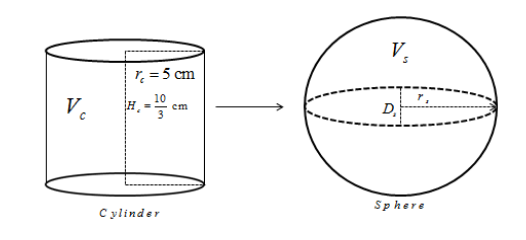Answer
414.6k+ views
Hint: The metallic cylinder is converted into a metallic sphere. In this conversion the volume remains the same for both the cylinder and sphere. So equate both the volumes and find the radius and then we can find diameter as twice the radius.
Complete step-by-step answer:

Given information
Cylinder:
Diameter of cylinder, ${D_c} = 5$ cm
Radius of the cylinder is given by,
${r_c} = \dfrac{D}{2}$
${r_c} = \dfrac{5}{2}$ cm
Height of the cylinder, ${H_c} = 3\dfrac{1}{3} = \dfrac{{10}}{3}$ cm
The volume of the cylinder is given by,
$V = \pi {r_c}^2{H_c} \cdots \left( 1 \right)$
Substituting the value of and in equation (1), we get
$\Rightarrow V = \pi {\left( {\dfrac{5}{2}} \right)^2}\left( {\dfrac{{10}}{3}} \right) \cdots \left( 2 \right)$
Sphere
Let the radius and diameter of the sphere be and respectively.
Volume of the sphere is given by,
${V_s} = \dfrac{4}{3}\pi {r_s}^3 \cdots \left( 3 \right)$
According to the question the metallic cylinder is converted into a metallic sphere. In this process of conversion the volume of the cylinder will be the same as that of the sphere.
Therefore, equating (2) and equation (3) , we get
$\Rightarrow \pi {\left( {\dfrac{5}{2}} \right)^2}\left( {\dfrac{{10}}{3}} \right) = \dfrac{4}{3}\pi {r_s}^3$
Cancelling the $\pi $ from both sides,
$\Rightarrow \left( {\dfrac{{25}}{4}} \right)\left( {\dfrac{{10}}{3}} \right) = \dfrac{4}{3}{r_s}^3$
There is only one variable in this equation and i.e. ${r_s}$ . Solving for ${r_s}$ we get,
$
\Rightarrow \left( {\dfrac{{25}}{4}} \right)\left( {\dfrac{{10}}{3}} \right) = \dfrac{4}{3}{r_s}^3 \\
\Rightarrow {r_s}^3 = \dfrac{{25 \times 10 \times 3}}{{4 \times 3 \times 4}} \\
\Rightarrow {r_s}^3 = \dfrac{{125}}{8} \\
\Rightarrow {r_s} = \sqrt[3]{{\dfrac{{125}}{8}}} \\
\Rightarrow {r_s} = 2.5{\text{ cm}} \\
$
The diameter of the sphere is twice its radius.
$
\Rightarrow {D_s} = 2{r_s} \\
\Rightarrow {D_s} = 2\left( {2.5} \right) \\
\Rightarrow {D_s} = 5{\text{ cm}} \\
$
Hence, the diameter of the sphere is, ${D_s} = 5{\text{ cm}}$.
Note: In problems of these types where one shape is converted into another shape, the concept of constant volume should be applied.
For instance, if the cone of radius ${r_c}$ and height ${h_c}$ is converted into a sphere of radius ${r_s}$ . then also the concept of constant volume is used as
Volume of cone = Volume of Sphere.
$\dfrac{1}{3}\pi {r_c}^2{h_c} = \dfrac{4}{3}\pi {r_s}^3$
The only unknown in this equation (i) is ${r_s}$ .So it can be solved for ${r_s}$.
Complete step-by-step answer:

Given information
Cylinder:
Diameter of cylinder, ${D_c} = 5$ cm
Radius of the cylinder is given by,
${r_c} = \dfrac{D}{2}$
${r_c} = \dfrac{5}{2}$ cm
Height of the cylinder, ${H_c} = 3\dfrac{1}{3} = \dfrac{{10}}{3}$ cm
The volume of the cylinder is given by,
$V = \pi {r_c}^2{H_c} \cdots \left( 1 \right)$
Substituting the value of and in equation (1), we get
$\Rightarrow V = \pi {\left( {\dfrac{5}{2}} \right)^2}\left( {\dfrac{{10}}{3}} \right) \cdots \left( 2 \right)$
Sphere
Let the radius and diameter of the sphere be and respectively.
Volume of the sphere is given by,
${V_s} = \dfrac{4}{3}\pi {r_s}^3 \cdots \left( 3 \right)$
According to the question the metallic cylinder is converted into a metallic sphere. In this process of conversion the volume of the cylinder will be the same as that of the sphere.
Therefore, equating (2) and equation (3) , we get
$\Rightarrow \pi {\left( {\dfrac{5}{2}} \right)^2}\left( {\dfrac{{10}}{3}} \right) = \dfrac{4}{3}\pi {r_s}^3$
Cancelling the $\pi $ from both sides,
$\Rightarrow \left( {\dfrac{{25}}{4}} \right)\left( {\dfrac{{10}}{3}} \right) = \dfrac{4}{3}{r_s}^3$
There is only one variable in this equation and i.e. ${r_s}$ . Solving for ${r_s}$ we get,
$
\Rightarrow \left( {\dfrac{{25}}{4}} \right)\left( {\dfrac{{10}}{3}} \right) = \dfrac{4}{3}{r_s}^3 \\
\Rightarrow {r_s}^3 = \dfrac{{25 \times 10 \times 3}}{{4 \times 3 \times 4}} \\
\Rightarrow {r_s}^3 = \dfrac{{125}}{8} \\
\Rightarrow {r_s} = \sqrt[3]{{\dfrac{{125}}{8}}} \\
\Rightarrow {r_s} = 2.5{\text{ cm}} \\
$
The diameter of the sphere is twice its radius.
$
\Rightarrow {D_s} = 2{r_s} \\
\Rightarrow {D_s} = 2\left( {2.5} \right) \\
\Rightarrow {D_s} = 5{\text{ cm}} \\
$
Hence, the diameter of the sphere is, ${D_s} = 5{\text{ cm}}$.
Note: In problems of these types where one shape is converted into another shape, the concept of constant volume should be applied.
For instance, if the cone of radius ${r_c}$ and height ${h_c}$ is converted into a sphere of radius ${r_s}$ . then also the concept of constant volume is used as
Volume of cone = Volume of Sphere.
$\dfrac{1}{3}\pi {r_c}^2{h_c} = \dfrac{4}{3}\pi {r_s}^3$
The only unknown in this equation (i) is ${r_s}$ .So it can be solved for ${r_s}$.
Recently Updated Pages
How many sigma and pi bonds are present in HCequiv class 11 chemistry CBSE

Why Are Noble Gases NonReactive class 11 chemistry CBSE

Let X and Y be the sets of all positive divisors of class 11 maths CBSE

Let x and y be 2 real numbers which satisfy the equations class 11 maths CBSE

Let x 4log 2sqrt 9k 1 + 7 and y dfrac132log 2sqrt5 class 11 maths CBSE

Let x22ax+b20 and x22bx+a20 be two equations Then the class 11 maths CBSE

Trending doubts
Fill the blanks with the suitable prepositions 1 The class 9 english CBSE

At which age domestication of animals started A Neolithic class 11 social science CBSE

Which are the Top 10 Largest Countries of the World?

Give 10 examples for herbs , shrubs , climbers , creepers

Difference between Prokaryotic cell and Eukaryotic class 11 biology CBSE

Difference Between Plant Cell and Animal Cell

Write a letter to the principal requesting him to grant class 10 english CBSE

Change the following sentences into negative and interrogative class 10 english CBSE

Fill in the blanks A 1 lakh ten thousand B 1 million class 9 maths CBSE



